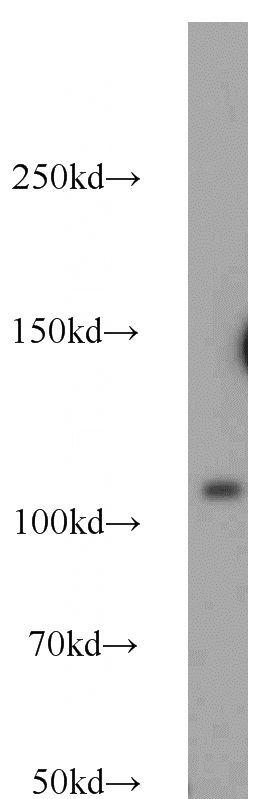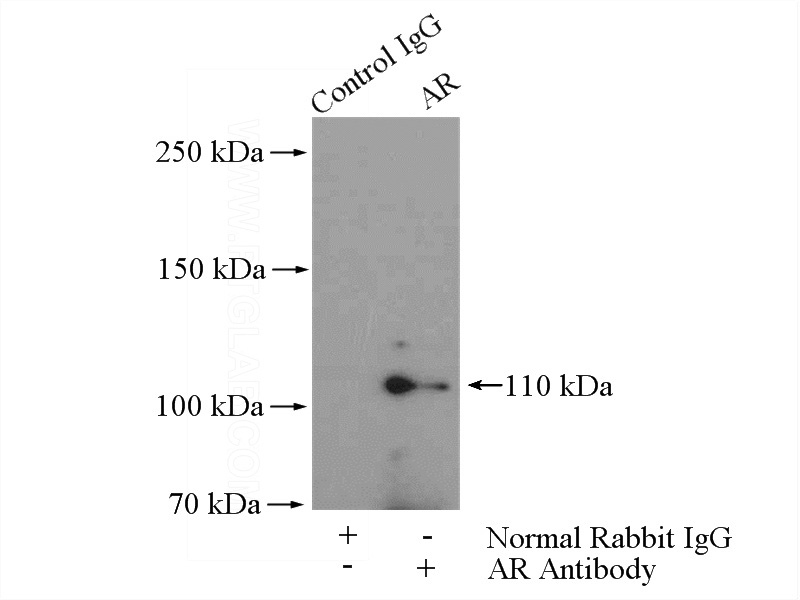-
Product Name
androgen receptor antibody
- Documents
-
Description
androgen receptor Rabbit Polyclonal antibody. Positive IP detected in HepG2 cells. Positive WB detected in HEK-293 cells, COS-7 cells, HepG2 cells. Observed molecular weight by Western-blot: 110 kDa
-
Tested applications
ELISA, WB, IP
-
Species reactivity
Human, Monkey; other species not tested.
-
Alternative names
AIS antibody; androgen receptor antibody; DHTR antibody; Dihydrotestosterone receptor antibody; HUMARA antibody; HYSP1 antibody; NR3C4 antibody; SBMA antibody; SMAX1 antibody; TFM antibody
-
Isotype
Rabbit IgG
-
Preparation
This antibody was obtained by immunization of androgen receptor recombinant protein (Accession Number: NM_000044). Purification method: Antigen Affinity purified.
-
Clonality
Polyclonal
-
Formulation
PBS with 0.02% sodium azide and 50% glycerol pH 7.3.
-
Storage instructions
Store at -20℃. DO NOT ALIQUOT
-
Applications
Recommended Dilution:
WB: 1:200-1:2000
IP: 1:200-1:2000
-
Validations

HEK-293 cells were subjected to SDS PAGE followed by western blot with Catalog No:108049(AR antibody) at dilution of 1:1000

IP Result of anti-AR (IP:Catalog No:108049, 4ug; Detection:Catalog No:108049 1:500) with HepG2 cells lysate 3600ug.
-
Background
Androgen receptor (AR) also konwn as Dihydrotestosterone receptor (DHTR), Nuclear receptor subfamily 3 group C member 4 (NR3C4).It is one of steriod hormoen receptors, which are ligand-activated transcription factors that regulate eukaryotic gene expression and affect cellular proliferation and differentiation in target tissues. Transcription factor activity is modulated by bound coactivator and corepressor proteins. Transcription activation is down-regulated by NR0B2. Activated, but not phosphorylated, by HIPK3 and ZIPK/DAPK3.Defects in AR are the cause of androgen insensitivity syndrome (AIS).Affected males have female external genitalia, female breast development, blind vagina, absent uterus and female adnexa, and abdominal or inguinal testes, despite a normal 46,XY karyotype.Defects in AR are the cause of spinal and bulbar muscular atrophy X-linked type 1 (SMAX1). In SMAX1 patients the number of Gln ranges from 38 to 62. Longer expansions result in earlier onset and more severe clinical manifestations of the disease.Defects in AR may play a role in metastatic prostate cancer. The mutated receptor stimulates prostate growth and metastases development despite of androgen ablation. This treatment can reduce primary and metastatic lesions probably by inducing apoptosis of tumor cells when they express the wild-type receptor.Defects in AR are the cause of androgen insensitivity syndrome partial (PAIS). PAIS is characterized by hypospadias, hypogonadism, gynecomastia, genital ambiguity, normal XY karyotype, and a pedigree pattern consistent with X-linked recessive inheritance. Some patients present azoospermia or severe oligospermia without other clinical manifestations.This antibody is a rabbit polyclonal antibody. It can specifically recognize the 110kd AR protein.
Related Products / Services
Please note: All products are "FOR RESEARCH USE ONLY AND ARE NOT INTENDED FOR DIAGNOSTIC OR THERAPEUTIC USE"
